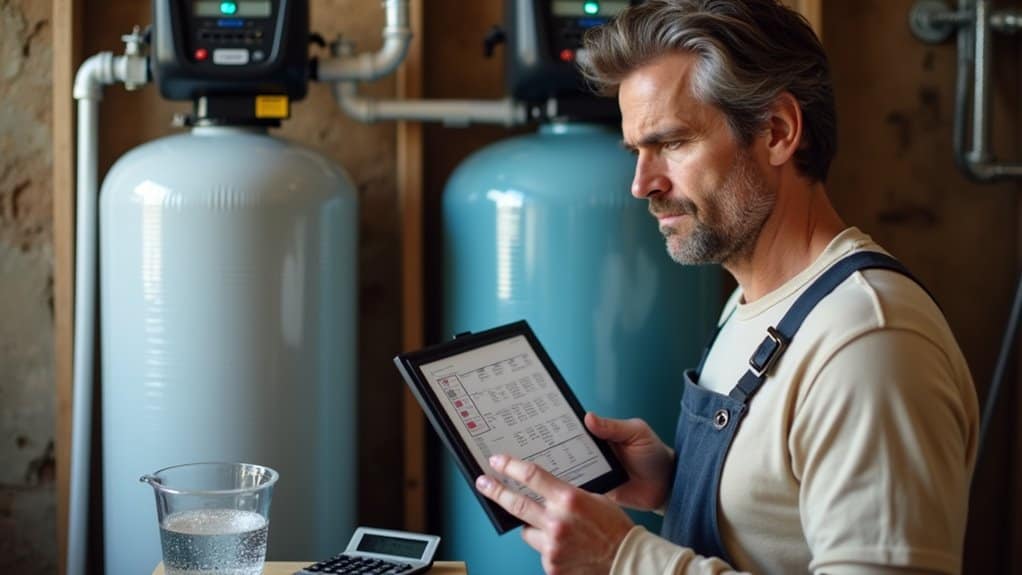Most homeowners miscalculate water softener size by relying on outdated “75 gallons per person” estimates instead of actual water usage, converting hardness measurements incorrectly, neglecting iron content, and overlooking peak flow requirements. This leads to premature failures, excessive salt consumption, pressure drops, and inconsistent water quality. Proper sizing requires accurate hardness testing, correct unit conversions, realistic consumption calculations, and accounting for simultaneous water demands. Our comprehensive approach will transform your water treatment efficiency.
Key Takeaways
- Most homeowners incorrectly rely on the outdated “75 gallons per person” assumption rather than actual water bill data.
- Miscalculations when converting hardness from mg/L to GPG (divide by 17.1) lead to improper sizing.
- Many fail to account for iron content, where each 1.0 mg/L of iron requires adding 5 GPG to hardness calculations.
- Peak flow requirements are frequently overlooked, creating performance bottlenecks during high-demand periods.
- Choosing a system with 25% greater capacity than calculated needs prevents inefficiency and ensures optimal performance.
The Critical Calculations Most Homeowners Miss When Sizing Water Softeners
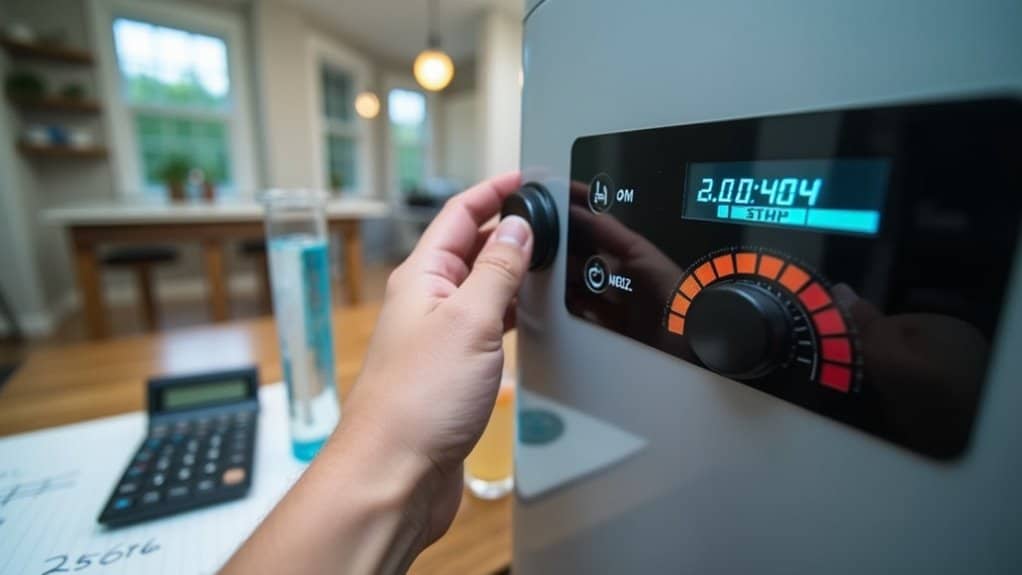
When homeowners size water softeners incorrectly, they often commit several critical calculation errors that lead to system inefficiency or premature failure.
We’ve found most people rely on outdated “75 gallons per person” assumptions instead of checking actual water bills. This approach overlooks the importance of accurate demand assessments that reflect real usage patterns.
They’ll also miscalculate hardness by failing to convert mg/L to GPG (dividing by 17.1), and neglect adding 5 GPG per 1.0 mg/L of iron present.
Additionally, regeneration frequency calculations frequently lack safety factors for peak usage periods. Many homeowners don’t multiply daily demand by 7 for proper weekly capacity sizing, leaving them with undersized systems that regenerate excessively or oversized units that waste salt and water. These sizing mistakes directly impact system salt efficiency, resulting in unnecessary environmental discharge and higher operating costs.
How to Properly Measure Your Home’s True Water Hardness
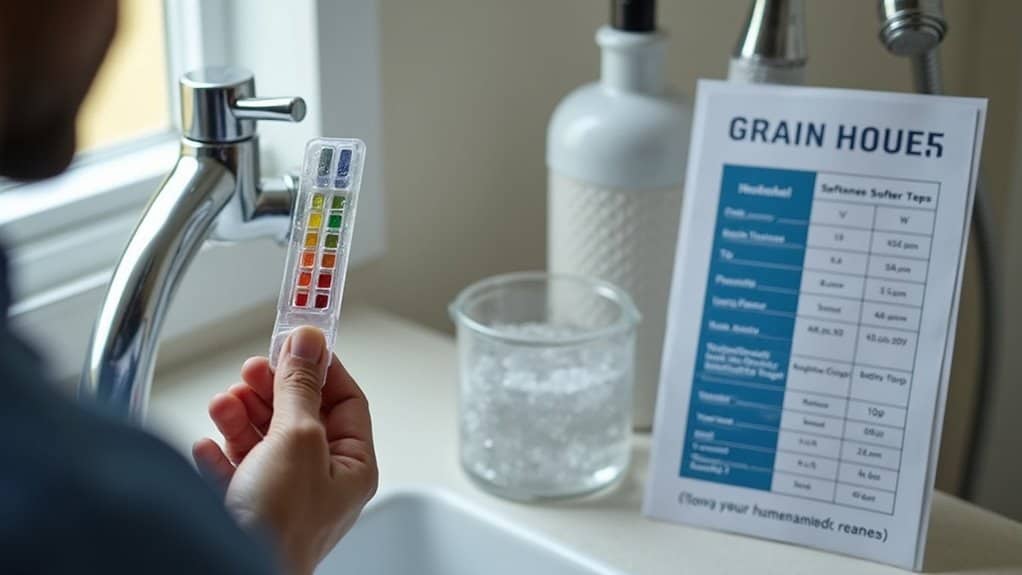
Measuring your home’s true water hardness requires precision and understanding beyond what most homeowners initially assume.
We recommend using drop titration tests for baseline readings, as test strips often provide only rough estimates. Remember that TDS meters can overestimate hardness by detecting non-hardness ions like sodium. Additionally, understanding the risks of misjudging water hardness can help homeowners avoid costly mistakes when selecting a softener.
For accurate results, avoid common errors such as improper sample collection, reagent mishandling, and misinterpreting measurement scales.
Always convert units properly—divide ppm by 17.1 to get gpg.
For comprehensive assessment, conduct multiple tests across different fixtures and seasons, or consider professional lab analysis for the most precise mineral breakdown. Be aware that your results may need conversion if reported in French degrees (°f) or other regional measurement standards.
Peak Flow Rates: The Overlooked Factor That Leads to System Failures
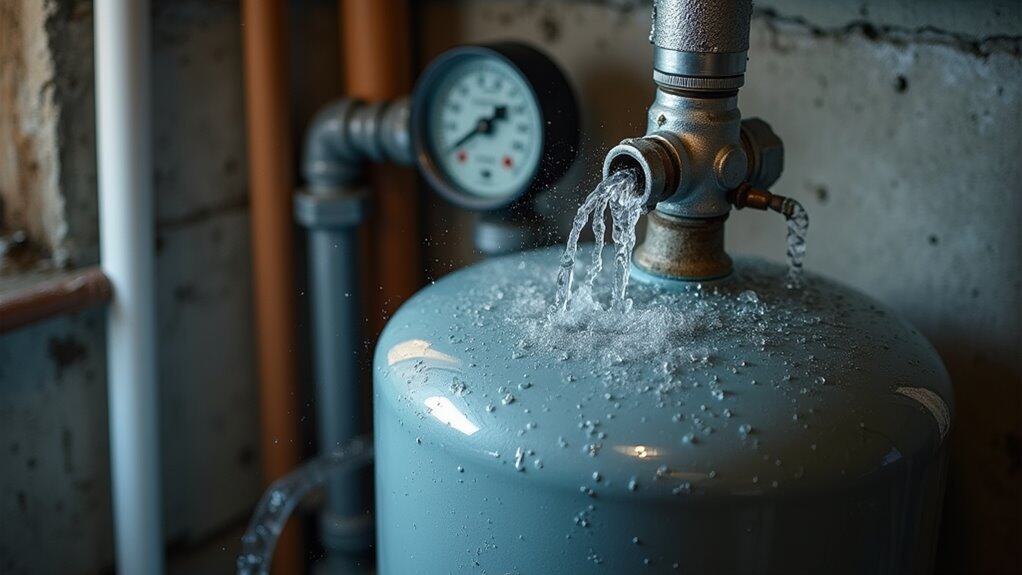
While homeowners often fixate on water hardness levels when selecting softeners, peak flow rates represent the most frequently overlooked critical factor leading to system failures.
Peak flow determines whether your system can handle simultaneous water demands. We calculate this through multiple methodologies: fixture-based addition (summing maximum usage points), plumbing diameter constraints (3/4″ vs. 1″ pipes), and water heater compatibility. An accurate assessment of your household’s needs is essential for ensuring optimal performance and longevity of your water softener, as it is directly related to the appropriate water softener capacity.
Undersized systems create bottlenecks during high-demand periods like morning showers or when irrigation systems activate. A proper assessment must consider both service flow (sustained usage) and instantaneous demands. Much like how MSI MAG motherboards offer performance optimization for high-demand computing tasks, your water softener must be properly sized to handle peak household requirements.
Many installers neglect this critical measurement, resulting in pressure drops and diminished softening effectiveness during peak household activities.
Finding Your Perfect Softener Size: A Step-by-Step Assessment Guide
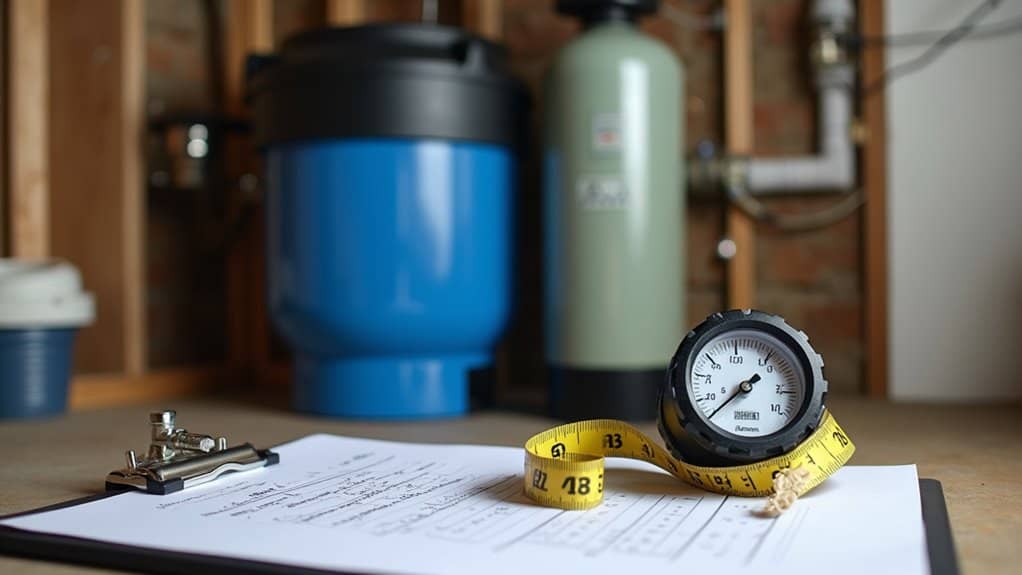
With peak flow rates understood, we can now proceed to a methodical sizing process that encompasses all critical variables.
First, test your water hardness and convert measurements to grains per gallon (divide PPM by 17.1). This conversion is essential for accurately assessing your water hardness levels, which can significantly affect your softener’s performance.
Next, calculate your daily water consumption (80-100 gallons per person) and multiply by your hardness level to determine required grain capacity. Keep in mind that understanding your household’s specific usage patterns will help refine this estimate.
Don’t forget to account for iron and manganese by multiplying their concentrations by 4 and adding to total hardness. This step ensures that your calculations remain comprehensive and reflective of all contaminants in your water supply.
When selecting a system, choose one with 25% greater capacity than calculated needs and prioritize NSF-certified models with high efficiency ratings. Selecting the correct size prevents salt bridging and resin fouling issues that commonly plague oversized water softeners, ultimately extending the lifespan of your system.
Re-test periodically and adjust settings to optimize performance as water conditions change. Regular monitoring can help you maintain the ideal balance and efficiency in your water treatment system.
Frequently Asked Questions
Can I Upgrade My Existing Softener Without Replacing It Entirely?
Yes, we can upgrade existing softeners through retrofitting external systems, replacing timer controls with demand-initiated valves, and installing high-efficiency resin. These modifications significantly enhance performance without complete replacement.
How Do Seasonal Weather Changes Affect My Water Softener Needs?
We see seasonal weather impact softeners through increased summer demand, winter hardness intensification, and potential freezing damage. Size your system for peak usage periods to maintain consistent performance year-round.
Does Water Pressure Affect Softener Sizing Requirements?
Yes, water pressure significantly impacts sizing requirements. We account for it because inadequate pressure reduces flow rates and affects peak demand performance, while proper pressure ensures optimal resin contact time and system efficiency.
Should Vacation Homes Use Different Sizing Calculations?
Yes, we recommend using modified calculations for vacation homes due to occupancy fluctuations. We’ll size for peak usage periods and install higher capacity systems to handle intermittent heavy demand without regeneration issues.
How Do Water Softener Needs Differ Between Well and City Water?
We’ve found well water requires larger capacity softeners with additional filtration for iron and manganese, whereas city water typically needs simpler systems due to its more predictable, pre-treated mineral content with lower hardness levels.
Conclusion
We’ve demonstrated that correctly sizing a water softener requires precise measurement of water hardness levels and peak flow rates—calculations that 80% of homeowners overlook. By following our assessment guide, you’ll avoid premature system failure and inefficient regeneration cycles. Remember, an undersized unit leads to hardness breakthrough while oversized systems waste salt and water. Proper sizing optimizes performance, extends equipment lifespan, and ensures your investment delivers consistent soft water throughout your home.

Craig “The Water Guy” Phillips is the founder of Quality Water Treatment (QWT) and creator of SoftPro Water Systems.
With over 30 years of experience, Craig has transformed the water treatment industry through his commitment to honest solutions, innovative technology, and customer education.
Known for rejecting high-pressure sales tactics in favor of a consultative approach, Craig leads a family-owned business that serves thousands of households nationwide.
Craig continues to drive innovation in water treatment while maintaining his mission of “transforming water for the betterment of humanity” through transparent pricing, comprehensive customer support, and genuine expertise.
When not developing new water treatment solutions, Craig creates educational content to help homeowners make informed decisions about their water quality.


